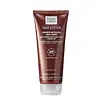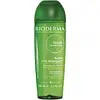What's inside
What's inside
 Key Ingredients
Key Ingredients

 Benefits
Benefits

 Concerns
Concerns

 Ingredients Side-by-side
Ingredients Side-by-side

Water
Skin ConditioningSodium Lauroyl Methyl Isethionate
CleansingCocamidopropyl Betaine
CleansingLauroyl/Myristoyl Methyl Glucamide
EmollientSodium Lauroyl Sarcosinate
CleansingCitric Acid
BufferingSodium Hyaluronate
HumectantSodium Phytate
Inositol
HumectantLactic Acid
BufferingMilk Protein
Skin ConditioningAcetyl Cysteine
AntioxidantAcetyl Methionine
Skin ConditioningApigenin
AntioxidantOleanolic Acid
Skin ConditioningBiotinoyl Tripeptide-1
Nicotiana Benthamiana Hexapeptide-40 Sh-Polypeptide-86
Nicotiana Benthamiana Hexapeptide-40 Sh-Polypeptide-9
Nicotiana Benthamiana Octapeptide-30 Sh-Oligopeptide-2
Skin ConditioningAcrylates Crosspolymer-4
Emulsion StabilisingTriethanolamine
BufferingSodium Levulinate
Skin ConditioningTrisodium Ethylenediamine Disuccinate
Glycol Distearate
EmollientPropylene Glycol
HumectantPolyquaternium-22
Steareth-4
EmulsifyingButylene Glycol
HumectantAlcohol Denat.
AntimicrobialPanthenyl Ethyl Ether
PPG-26-Buteth-26
Skin ConditioningPEG-40 Hydrogenated Castor Oil
EmulsifyingAlcohol
AntimicrobialLactose
HumectantSodium Citrate
BufferingPhosphate Buffered Saline
SolventTris Buffered Saline
BufferingParfum
MaskingSodium Benzoate
MaskingPotassium Sorbate
PreservativeSorbic Acid
PreservativePhenoxyethanol
PreservativeDehydroacetic Acid
PreservativeCI 19140
Cosmetic ColorantCI 16255
Cosmetic ColorantWater, Sodium Lauroyl Methyl Isethionate, Cocamidopropyl Betaine, Lauroyl/Myristoyl Methyl Glucamide, Sodium Lauroyl Sarcosinate, Citric Acid, Sodium Hyaluronate, Sodium Phytate, Inositol, Lactic Acid, Milk Protein, Acetyl Cysteine, Acetyl Methionine, Apigenin, Oleanolic Acid, Biotinoyl Tripeptide-1, Nicotiana Benthamiana Hexapeptide-40 Sh-Polypeptide-86, Nicotiana Benthamiana Hexapeptide-40 Sh-Polypeptide-9, Nicotiana Benthamiana Octapeptide-30 Sh-Oligopeptide-2, Acrylates Crosspolymer-4, Triethanolamine, Sodium Levulinate, Trisodium Ethylenediamine Disuccinate, Glycol Distearate, Propylene Glycol, Polyquaternium-22, Steareth-4, Butylene Glycol, Alcohol Denat., Panthenyl Ethyl Ether, PPG-26-Buteth-26, PEG-40 Hydrogenated Castor Oil, Alcohol, Lactose, Sodium Citrate, Phosphate Buffered Saline, Tris Buffered Saline, Parfum, Sodium Benzoate, Potassium Sorbate, Sorbic Acid, Phenoxyethanol, Dehydroacetic Acid, CI 19140, CI 16255
Water
Skin ConditioningCaprylyl/Capryl Glucoside
CleansingPEG-150 Distearate
EmulsifyingPEG-6 Caprylic/Capric Glycerides
EmulsifyingPEG-15 Cocopolyamine
EmulsifyingSodium Lauroyl Oat Amino Acids
CleansingLactic Acid
BufferingSodium Citrate
BufferingCaprylyl Glycol
EmollientQuaternium-80
Propylene Glycol
HumectantMannitol
HumectantXylitol
HumectantRhamnose
HumectantPhenoxyethanol
PreservativeTetrasodium EDTA
Ethylhexylglycerin
Skin ConditioningFructooligosaccharides
HumectantSodium Hydroxide
BufferingParfum
MaskingWater, Caprylyl/Capryl Glucoside, PEG-150 Distearate, PEG-6 Caprylic/Capric Glycerides, PEG-15 Cocopolyamine, Sodium Lauroyl Oat Amino Acids, Lactic Acid, Sodium Citrate, Caprylyl Glycol, Quaternium-80, Propylene Glycol, Mannitol, Xylitol, Rhamnose, Phenoxyethanol, Tetrasodium EDTA, Ethylhexylglycerin, Fructooligosaccharides, Sodium Hydroxide, Parfum
Alternatives
Ingredients Explained
These ingredients are found in both products.
Ingredients higher up in an ingredient list are typically present in a larger amount.
Lactic Acid is another well-loved alpha hydroxy acid (AHA). It is gentler than glycolic acid but still highly effective.
Its main role is to exfoliate the surface of the skin by loosening the “glue” that holds dead skin cells together. Shedding those old cells leads to smoother, softer, and more even-toned skin.
Because lactic acid molecules are larger than glycolic acid, they don’t penetrate as deeply. This means they’re less likely to sting or irritate, making it a great choice for beginners or those with sensitive skin.
Like glycolic acid, it can:
Lactic acid also acts as a humectant (like hyaluronic acid). It can draw water into the skin to improve hydration and also plays a role in the skin's natural moisturizing factor (NMF) in the form of sodium lactate.
Studies show it can boost ceramide production to strengthen the skin barrier and even help balance the skin’s microbiome.
To get results, choose products with a pH between 3-4.
Lower strengths (5-12%) focus on surface exfoliation; higher strengths (12% and up) can reach deeper in the dermis (deeper, supportive layer) to improve skin texture and firmness over time.
Though it was originally derived from milk, most modern lactic acid used in skincare is vegan. It is made through non-dairy fermentation to create a bio-identical and stable form suitable for all formulations.
When lactic acid shows up near the end of an ingredient list, it usually means the brand added just a tiny amount to adjust the product’s pH.
Legend has it that Cleopatra used to bathe in sour milk to help reduce wrinkles.
Lactic acid is truly a gentle multitasker: it exfoliates, hydrates, strengthens, and brightens. It's a great ingredient for giving your skin a smooth, glowing, and healthy look without the harshness of stronger acids.
Read more about some other popular AHA's here:
Learn more about Lactic AcidParfum is a catch-all term for an ingredient or more that is used to give a scent to products.
Also called "fragrance", this ingredient can be a blend of hundreds of chemicals or plant oils. This means every product with "fragrance" or "parfum" in the ingredients list is a different mixture.
For instance, Habanolide is a proprietary trade name for a specific aroma chemical. When used as a fragrance ingredient in cosmetics, most aroma chemicals fall under the broad labeling category of “FRAGRANCE” or “PARFUM” according to EU and US regulations.
The term 'parfum' or 'fragrance' is not regulated in many countries. In many cases, it is up to the brand to define this term.
For instance, many brands choose to label themselves as "fragrance-free" because they are not using synthetic fragrances. However, their products may still contain ingredients such as essential oils that are considered a fragrance by INCI standards.
One example is Calendula flower extract. Calendula is an essential oil that still imparts a scent or 'fragrance'.
Depending on the blend, the ingredients in the mixture can cause allergies and sensitivities on the skin. Some ingredients that are known EU allergens include linalool and citronellol.
Parfum can also be used to mask or cover an unpleasant scent.
The bottom line is: not all fragrances/parfum/ingredients are created equally. If you are worried about fragrances, we recommend taking a closer look at an ingredient. And of course, we always recommend speaking with a professional.
Learn more about ParfumPhenoxyethanol is a preservative that has germicide, antimicrobial, and aromatic properties. Studies show that phenoxyethanol can prevent microbial growth. By itself, it has a scent that is similar to that of a rose.
It's often used in formulations along with Caprylyl Glycol to preserve the shelf life of products.
Propylene Glycol is an odorless, colorless liquid. As a humectant, it helps skin retain moisture. It also aids in delivering active ingredients.
Another role of this ingredient is preventing a product from melting or freezing. Propylene glycol also adds antimicrobrial properties to a product, elongating product lifespan.
This ingredient is considered an organic alcohol and commonly added into both cosmetics and foods.
Those with sensitive skin or conditions may develop a rash when using this ingredient.
Learn more about Propylene GlycolSodium Citrate is the sodium salts of citric acid. In skincare, it is used to alter pH levels and acts as a preservative.
Its main functions are to maintain the pH of a product and neutralize metal ions.
The acidity of our skin is maintained by our glands and skin biome; normal pH level of skin is slightly acidic (~4.75-5.5).
Being slightly acidic allows our skin to create an "acid mantle". This acid mantle is a thin barrier that protects our skin from bacteria and contaminants.
Learn more about Sodium CitrateWater. It's the most common cosmetic ingredient of all. You'll usually see it at the top of ingredient lists, meaning that it makes up the largest part of the product.
So why is it so popular? Water most often acts as a solvent - this means that it helps dissolve other ingredients into the formulation.
You'll also recognize water as that liquid we all need to stay alive. If you see this, drink a glass of water. Stay hydrated!
Learn more about Water